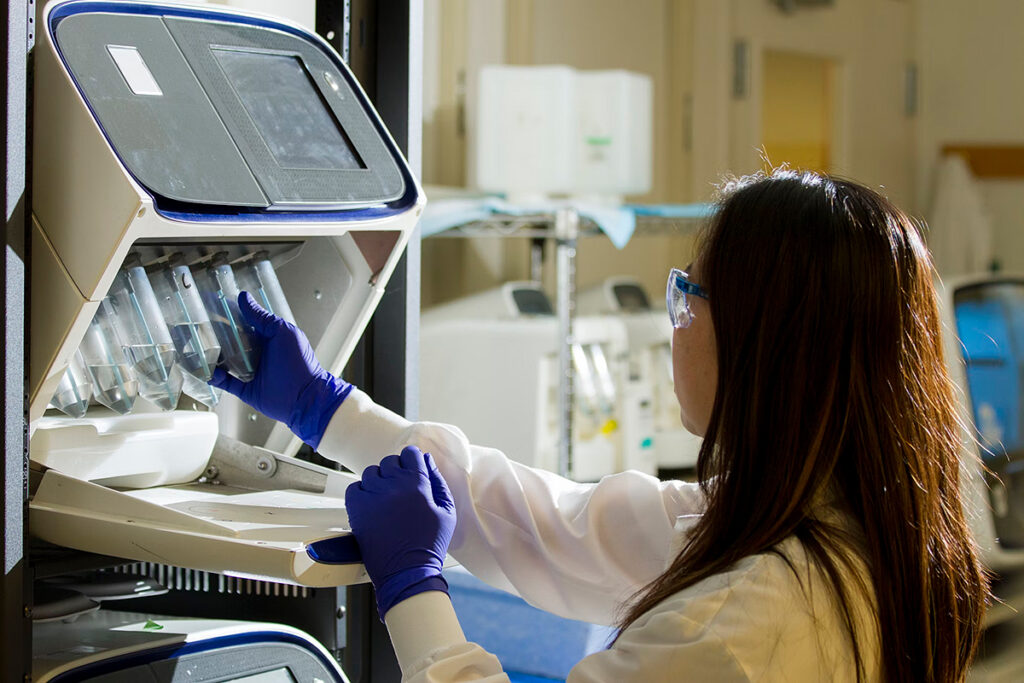Yogurt – milk fermented with thermophilic Streptococcus and Bulgarian bacillus (Streptococcus thermophilus and Lactobacillus bulgaricus) – is considered a functional food because probiotics can have positive health effects, and these effects go beyond their high nutritional value. Animal and human studies have shown that the use of probiotics improves the composition of the intestinal microbiome and can increase natural and acquired immunity.:
- Diet, longevity, and COVID-19. How to adjust your diet to strengthen your antiviral protection and live longer.
- Gut microbiota as a health regulator. Probiotics improve the balance of intestinal microorganisms and the level of short-chain fatty acids. The role of probiotics in health promotion and disease prevention.
However, although regular yogurt is the most commonly consumed globally, only a few studies have examined the effects of yogurt consumption on the human immune system.
Lactic acid bacteria affect the production of cytokines
Lactic acid bacteria contained in yogurt significantly increase the production of IFN-gamma. That is confirmed by an Austrian study from 2007. In this study, 2 groups of young, healthy women consumed yogurt or probiotic yogurt daily for two weeks. Both yogurts contained Lactobacillus bulgaricus and Streptococcus thermophilus, and the probiotic additionally had Lactobacillus casei DN 114 001. Cytokine production in the blood was measured by cytometry and enzyme immunoassay after stimulation with phytohemagglutinin and lipopolysaccharide. Both regular yogurt and probiotic yogurt increased the production of proinflammatory cytokines after stimulation:
- Stimulated production of tumor necrosis factor-alpha (TNF-alpha) increased significantly after regular or probiotic yogurt (+63% and + 24% compared to baseline).
- Significantly increased production of interleukin (IL) 1 beta in the regular yogurt group (+ 40%) and interferon-gamma in the probiotic group (+ 108%).
- IL-10 decreased after consumption of probiotic yogurt but increased significantly after discontinuation (+ 129%).
- No significant differences in cytokine responses were observed between regular yogurt and probiotic yogurt.
Theoretically, increased production of IFN-gamma can make the immune response to infection more effective.
A 1998 American study also showed that S. thermophilus and L. bulgaricus stimulate cytokine production. In this study, the production of cytokines IL-6, TNF-alpha, IL-2, and IL-5 was evaluated using macrophages and T helper cells •
- The production of IL-6 by macrophages increased significantly in the range of 31 to 192 times.
- S. thermophilus strongly stimulated the production of TNF-alpha-from 135 to 176 times.
- Production of IL-6 and, to a lesser extent, TNF-alpha also increased when macrophages were co-stimulated by lipopolysaccharide and lactic acid bacteria.
- The stimulation of T-helper cells significantly increased IL-2 and IL-5, with S. thermophilus being the most effective.
- S. thermophilus stimulated macrophage and T-cell cytokines expression to the same or greater extent than Bifidobacterium and Lactobacillus.
Stimulating the immune system with lactic acid bacteria used in the production of yogurt increases resistance to pathogens. It is confirmed by the study of the protective functions of lactic acid bacteria Lactobacillus casei in mice. L. casei increased the production of IgA antibodies by the intestinal mucosa. This increased IgA secretion was sufficient to prevent intestinal infection.
Additional effects of probiotics are to eliminate the age-related decline in cytokine production. For example, the addition of several types of probiotics to the diet of aging mice restored the levels of IFN-gamma and IFN-alpha compared to control mice.
Insufficient nutrition causes interferon-gamma decrease
Spanish and Moroccan scientists have investigated how the daily consumption of yogurt affects the production of IFN-gamma by immunocompetent cells. The study involved malnourished patients: Moroccan children with diarrhea and Spanish teenage girls with anorexia nervosa.
Diarrhea in malnourished children
Of the 10.7 million deaths per year among children under 5, 49% are associated with malnutrition. The most common causes are respiratory complications and diarrhea. In Morocco, 21% of deaths among children under 5 years of age are associated with diarrhea, and 11% are related to respiratory diseases. The 1990 National Survey found that children under the age of 5 suffered an average of eight episodes of acute diarrhea per year. In hospitals in Morocco, childhood diarrhea is 5.2%, mainly among children under 2 years of age.
Anorexia nervosa as an example of malnutrition in industrialized countries
Nervosa Anorexia (NA) is a syndrome characterized by an intense fear of fullness and refusal to eat to lose weight or reduce weight below normal. Over time, patients with NA develop severe malnutrition and increase the risk of death from various diseases.
Studies on the effects of malnutrition on the immune system have led to conflicting conclusions. Patients with NA are often prone to leukopenia along with relative lymphocytosis. These patients also have a reduced response to the delayed hypersensitivity skin test (DHT). However, the proliferative response of lymphocytes is usually expected. Thus, even though some immune disorders in NA are similar to those observed in uncomplicated malnutrition, immune function is preserved better than expected, given the inferior nutritional status of patients. As for the production of cytokines, patients with NA have reduced production of IFN-gamma, which may be associated with a violation of the immune system’s response to pathogenic microorganisms. The following studies confirm this:
- TNF, interferon-gamma and cellular cytotoxicity in anorexia nervosa; the effect of resuming nutrition.
- Low production of interferon-gamma by lymphocytes and variable proliferative response in patients with anorexia nervosa.
Effect of lactic acid bacteria on interferon-gamma production in children with diarrhea
The study involved 22 children aged 6 to 24 months with a weight-to-height ratio of 70 to 80%. The children were admitted to the Rabat Children’s Hospital (Morocco) for 18 months with noticeable weight loss, diarrhea, and/or persistent respiratory infections. The children were not breastfed, except for two who maintained this condition when included in the study. The study did not include children who had particular complications or needed a blood transfusion.
Upon admission to the hospital, the children received oral rehydration serum and broad-spectrum antibiotics. Each patient was assigned a milk or yogurt-based diet with lactic acid bacteria L. bulgaricus and S. thermophilus. Initially, children received 100 kcal / kg / day in 8-12 doses. After weight gain, food was increased to 150 and 200 kcal/kg/day; vegetable, meat and fruit soups were also gradually introduced. Ferrous sulfate supplementation (100 mg/day) was given when the intake reached 150 kcal/kg/day. This supplement persisted for 2 months after discharge.
To measure the production of IFN-gamma, two peripheral blood samples were obtained: at admission and at discharge-when the children reached 90% of the standard weight in height and adequate general condition. IFN-gamma was measured in supernatants from peripheral blood mononuclear cells cultured in the presence of yogurt bacteria (L. bulgaricus and S. thermophilus).
The control group consisted of 12 healthy children aged 12 to 24 months with a weight-to-height ratio of 100%, following the standards of the US National Center for Health Statistics (NCHS). These children usually consumed 100 ml of milk per day. The protocol used in this study established an initial intake of 300 ml of semi-raw milk per day for 15 days, followed by 300 ml of yogurt made with semi-raw milk for another 15 days, in addition to the regular diet. Three blood samples were taken from each subject: at the study inclusion and its 15th and 30th days. The parameters assessed were the same as for malnourished children.
Results
IFN-gamma production in malnourished children varied at the individual level. However, in the control group of children, yogurt consumption for 15 days significantly increased the production of IFN-gamma. In both groups of malnourished children, an increase in IFN-gamma production was observed after restoring nutrition on both yogurt and a dairy diet. However, it is essential to emphasize that after diet therapy in malnourished children, only 33% of those who received the milk diet experienced an increase in the level of IFN-gamma, while in the group receiving the yogurt diet, an increase in the level of IFN-gamma was observed in 80% of children.
How lactic acid bacteria affect interferon-gamma expression in patients with anorexia nervosa
This group included 31 teenage girls who suffered from anorexia nervosa aged from 12 to 18 years. The treatment was carried out in the Department of eating disorders of the Nino Jesus Hospital (Madrid, Spain) with the help of cognitive-behavioral therapy and psychopharmacological drugs. Nutritional support provided an initial diet of 1,500 kcal/day, followed by an increase in calories prescribed until the level of 2,500 – 3,000 kcal/day was reached. 27 subjects completed the entire study.
The 27 girls were randomly assigned to one of two groups that received the opposite pattern of milk and yogurt intake as part of their daily diet:
- The first group (16 girls) received three yogurts (375 g) a day and no milk for 10 weeks, and for the next 10 weeks, received two glasses of milk (450 g) a day, but no yogurt.
- The second group (11 girls) received two glasses of milk a day and did not consume yogurt for the first 10 weeks, and in the next 10 weeks, switched to three yogurts and did not consume milk.
Peripheral blood samples were collected at 0, 6, 10, 16, and 20 weeks. IFN-gamma production was analyzed using ELISA kits. All patients began the study during inpatient treatment and continued the study protocol after discharge. Yogurts were delivered every 2 weeks to patients’ homes.
Results
There were no significant differences in body mass index (BMI) between the two groups of patients who followed the “yogurt – milk” or “milk – yogurt” diets. The increase in body mass index was achieved during the first 6 weeks of the study. However, no further changes in BMI were observed, despite the still low weight.
Both groups of patients with NA had a high percentage of undetectable levels of IFN-gamma. Serum IFN-gamma values were shallow in the few patients who had a measurable concentration.
The production of IFN-gamma in patients with NA differed at the individual level. IFN-gamma production increased in the first group after eating yogurt for 10 weeks, and these levels remained unchanged during the period of milk consumption. However, IFN-gamma production decreased significantly in the second group of patients after 10 weeks of milk consumption, and baseline levels were restored after 10 weeks of yogurt intake.
Conclusions
Yogurt is considered a healthy food with high nutritional value and functional properties. Many of them are associated with live bacteria found in yogurt. The most studied are the beneficial effects of the interaction of lactic acid bacteria with the intestinal microflora, which can prevent intestinal infections. However, these living bacteria can also interact with intestinal epithelial cells, cross the intestinal barrier, interact with lymphocytes, and have immunomodulatory properties.
Previous studies have noted the ability of lactic acid bacteria in yogurt to increase the production of cytokines, especially IFN, in healthy adults. A study involving patients with insufficient nutrition after taking yogurt, improvements in biochemical parameters, subsets of lymphocytes, and moderate production of IFN-gamma was also observed. Therefore, yogurt can be helpful in the treatment of patients with malnutrition. Furthermore, an increase in IFN-gamma production after eating yogurt may improve protection against pathogens.
Sources
- The effect of fermented milk on interferon production in malnourished children and in anorexia nervosa patients undergoing nutritional care
- Probiotic, as well as conventional yogurt, can enhance the stimulated production of proinflammatory cytokines
- Stimulation of cytokine production in clonal macrophage and T-cell models by Streptococcus thermophilus: comparison with Bifidobacterium sp. and Lactobacillus bulgaricus



